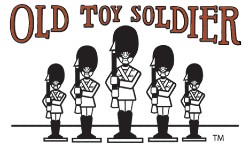Toy company Azrak-Hamway International, Inc (AHI), doing business as REMCO Toys, took its name from Marvin Azrak and Ezra Hamway, partners in the New York firm which marketed this recently discovered box of 30mm “Miniature Animals.”
The AHI company was featured as a chapter in my book The Toy Soldier Artistry of Holger Eriksson – Authenticast, SAE and Malleable Mouldings: Military History in Miniature. But this set of animals was not discovered until after that book was published. As noted in the caption, most of the animals have neat card bases, but these were probably added by the buyer ex post rather than when they were originally manufactured.
AHI made toy soldiers and other figures in 30mm, 40mm and 54mm scales, but they get little respect from collectors. Many confuse their products with almost identical SAE figures. AHI did come up with some figures NOT copied from those of other companies, but its favorite business model seemed to be the copying of figures made by other toy soldier manufacturers. It farmed out the production of “its” figures to independent Japanese factories. AHI also made figures and other categories of toys not known to have been copied from anybody’s items.
A few manufacturers attacked AHI for what they claimed was infringement.* Sometimes AHI won a lawsuit. (AHI prevailed in both the trial court and in the appeals court in both suits whose citations are set out in simplified version below.) The gist of the suits seemed often to be something to the effect: “We made this thing first; AHI copied or mimicked our product without our approval; We want it to stop doing that and to pay us some money for our damages and annoyance”.
As a small company, SAE didn’t have the wherewithal to fight with AHI in the courts. It is almost 8,000 miles between Cape Town, where SAE had its factory, and New York City where AHI was located and where suit would have to be tried. Even after it was obvious AHI was copying SAE’s figures, SAE didn’t follow any of the steps Britains, Ltd took in the courts to protect whatever copyright it may have had. Neither did lead figures’ designer and sculptor Holger Eriksson do so. “HE” as he is known to collectors, was a totally independent contractor in Sweden who sculpted and sold orignal masters to Curt Wennberg’s South Africa SAE factory. HE didn’t formally restrict anyone from reproducing his models. In fact, Eriksson kept back for his own later sales many of the figures he sold to Wennberg as masters. Erikkson listed for sale his 30mm Charles XII and various portrait figures in his first, January 1963 catalog, prior to selling those figures to a predecessor of Tradition of London.
AHI also copied SAE’s green and white boxes with scenic backgrounds. It even copied the position of its lettering to mimic the SAE logo and lettering positions. AHI’s green boxes contained either six marching or fighting 30mm figures on foot or else three men on horses, thereby mimicking the number of figures SAE placed in each box. Like SAE, it printed a list of its wares and bound it to the box with cellophane wrapping. It also used SAE’s folded slots to secure the figures in the box. The only thing not copied exactly was AHI’s logo printed between and the words “”Tru-size Metal” and “Miniature Figures.” AHI flourished selling through dimestores using cellophane bags attached to hanger tags. It sold its green box sets in dimestores for 49 cents, beating SAE’s $1.00 price in hobby stores. The cello bags’ tags claimed the figures were “DIECAST.” The definition of “die cast” implies force as opposed to merely pouring molten lead into a mold.
Among the companies whose products were borrowed by AHI‘s copying were British Cherilea’s 54mm knights in battle, scaled down to 30mm; metal copies of American Louis Marx Company’s solid plastic Robin Hood as well as its Captain Kidd figures; copies of the manufacturer Harvey’s 54mm Cowboys fighting and shooting, plastic figures; as well as copies of Britains Herald series Cowboys and Indians and their Modern British Infantry (marketed by AHI as Set 8910MA “U.S. Marines”). With respect to the Harvey figures, the British company had itself shifted to plastic, re-releasing a number of its hollow-cast figures in plastic under the “Lone Star” brand name. AHI reversed this trend, reverting back to hollowcast while Britains and Harvey were doing the opposite!
The Japanese 30mm production yielded a “rounded look” for figures already headed in that direction by SAE’s inability to faithfully reproduce Eriksson’s highly detailed masters. Painting in Japan was more carefully done, though some figures suffered in translation. For instance, for unknown reason, SAE’s Cape Town painters evidently believed the U.S. Marine Corp’s flag was black with a white design instead of it having a red field for a background. That same error appears in the AHI Japanese version. British Guards are painted by both SAE and AHI in red coats and black trousers. However, some of AHI’s Guards wear all-black uniforms with white belts and bearskin caps, a sort of Royal Marine Guards variation.
Nevertheless, AHI represents an interesting niche for collectors, where a small cameo collection can be assembled at modest cost.
*MATTEL, INC et al vs. AZRAK-HAMWAY International dba Remco Toys et al, 724 Fed. 2nd 357 1983 [5 1/2 “ action figure] *NICKERBOCKER TOY COMPANY VS. AZRAK-HAMWAY International, 668 Fed 2nd 699 1982 [“Wrist Racers”]
Special thanks to Norman Joplin for his research, which sorts the origins of some of the AHI-copied figures; See his book The Great Book of Hollow-Cast Figures, which identifies manufacturers whose products morphed into other companies’ toy figures via purchase or outright copying.


